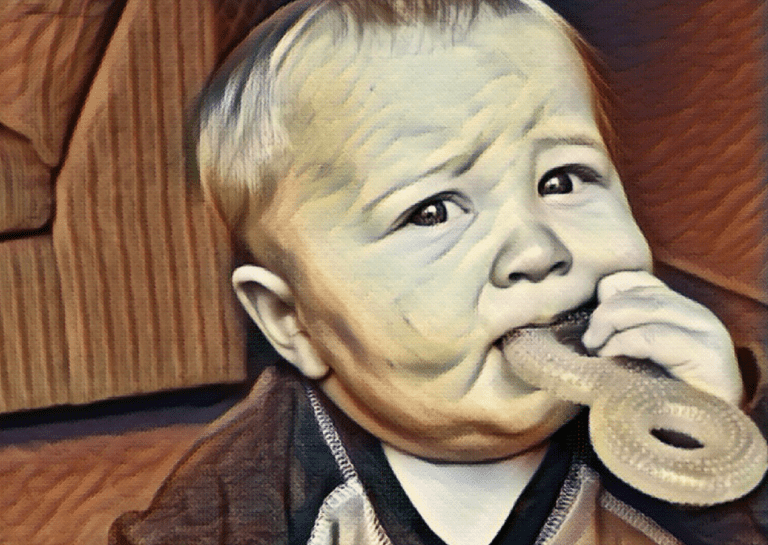Teething, also known as tooth eruption, is when your baby’s first teeth grow and emerge from the gum line. Although this is an important part of their growth and development, it can cause pain, discomfort, and irritability.
Learn what to expect when your baby starts teething, and how to care for your baby’s oral health during and after teething.
When to expect when teething
Babies typically begin teething between 6 and 10 months of age, but every baby is different and some can start much earlier or later than others. For example, girls will often start teething before boys. Parents should not be alarmed if their baby starts teething as late as twelve months old. Babies have a total of twenty teeth and usually have their full set by age 3.
Symptoms
Teething is not painful for all babies and symptoms can vary. Some symptoms that indicate your baby has started teething are:
- Crankiness
- Excessive drooling
- Chewing on objects
- Irritability
- Swollen gums
- Temperature increases
- Putting hands in mouth
- Coughing
- Disturbed appetite or sleeping patterns
Many of the symptoms displayed in teething babies are not exclusive to tooth eruption and should not be ignored or automatically attributed to it.
While teething can cause temperature spikes, it is not associated with fever (100.4˚F or higher). Babies who display symptoms such as fever and diarrhea may have a separate condition not related to teething, such as a bacterial infection, and should be seen by a doctor.
What to do to soothe a teething baby
Teething can usually be managed at home by a parent. Unless your baby shows serious symptoms or develops a fever, there is generally no need to see a doctor. But if your baby is experiencing pain and discomfort while teething, there are steps you can take to offer some relief.
- Teething ring — A chilled teething ring can be used to reduce pain and swelling in the gums. Ensure that the teething ring is not frozen and only use teething rings that are in one piece to avoid the risk of choking. Do not dip the teething ring in sugary substances as this can cause cavities in your baby’s new teeth. When choosing a teething ring, opt for ones made from a durable material such as rubber as opposed to breakable plastic. Avoid teething rings containing a liquid that could leak into your baby’s mouth in case of breakage.
- Gum massage — Another way to provide pain relief to teething babies is to massage the gums. Dip clean hands into cold water and gently massage your baby’s gums or let them chew on your fingers for cooling relief.
- Pain relief medication — If your baby is inconsolable due to teething pain, you can offer a small dose of acetaminophen. Always consult your doctor before giving your baby medication. Ask for advice about what medication and dosage is appropriate for your baby.
What not to do
There are several remedies for teething pain that may actually do more harm than good. Over-the-counter pain killers and homeopathic remedies are not recommended for treating teething pain, and can even be dangerous for babies. Prescription-strength topical medications such as benzocaine and lidocaine should also be avoided.
Some homeopathic remedies have been found to contain dangerous amounts of deadly nightshade (Atropa Belladonna), a poisonous plant that can cause seizures, lethargy, and breathing difficulties in babies.
Caring for your baby’s teeth
Proper oral hygiene is essential for protecting your baby’s teeth from cavities and decay once they emerge from the gums. Take the following steps to keep your baby’s mouth healthy during and after teething.
Before teeth come in
- Using a clean washcloth, wipe your baby’s gums after feeding or at least once a day.
After teeth come in
- Use a small, bristled toothbrush to gently clean your baby’s teeth twice a day. Use only water and avoid using toothpaste.
- When your baby’s first tooth comes in, make an appointment for a dental exam.
References
Macknin ML, Piedmonte M, Jacobs J, Skibinski C. Symptoms associated with infant teething: a prospective study. Pediatrics. 2000 Apr;105(4 Pt 1):747-52. doi: 10.1542/peds.105.4.747. PMID: 10742315.
Marks SC Jr. The basic and applied biology of tooth eruption. Connect Tissue Res. 1995;32(1-4):149-57. doi: 10.3109/03008209509013718. PMID: 7554911.
Wake M, Hesketh K, Lucas J. Teething and tooth eruption in infants: A cohort study. Pediatrics. 2000 Dec;106(6):1374-9. doi: 10.1542/peds.106.6.1374. PMID: 11099591.
